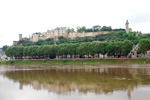History
Château d'Ussé resides in the Loire Valley of France, overlooking the River Indre. Today the castle is home to the Duc de Blacas, whose family has lived here for over two centuries.

The initial wooden stronghold was built to protect its inhabitants from the wars in the 10th and 11th centuries that raged across Touraine. Gelduin I from Denmark built the fortress during Viking raids along the River Loire and its environs, joining forces with the Counts of Blois. He was nicknamed the Devil of Saumur after several victories against Fulk Nerra, the Count of Anjou.
The second half of the 15th century saw the wooden castle replaced by stone during a period of unrest as part of the Hundred Years' War. The stone castle was erected by Jean V de Bueil, a Charles VII captain and a Joan of Arc companion. De Bueil came into possession of the castle through the marriage of his son, Antione de Bueil, who married Jeanne de Valois, daughter of Charles VII. At this time, the keep, the south wing, and portions of the east wing, which all still stand today, were constructed.
By 1485, Antoine de Bueil was bankrupt and sold the estate to Jacques d'Espinay, chamberlain to Louis XI and Charles VIII, who completed the east wing and added the gatehouse and the west building in an early Renaissance style.
In 1659, Château d'Ussé passed to Louis Bernin de Valentinay, controller-general of the royal household, who planned the layout of the apartments in the south gallery, the conversion of the west wing, and the completion of the grand staircase, designed by Francois Mansart. The writer Charles Perrault was a frequent visitor to the castle in the late 17th century. He found the castle and gardens so charming that they inspired his fairy tale, Sleeping Beauty.
In 1780, the castle was purchased by the Duc de Rohan Montbazon, a peer of France. During this period, the King's Bedchamber was added and furnished. But in 1785, following Rohan's family bankruptcy, Château d'Ussé was again sold, this time to Louis Vincent Roger de Chalabre, Knight of the Order of Saint Louis, whose family remained the owners through the French Revolution, which gave cause to spare the castle of destruction that was occurring across France at Royal castles during the Revolution.
Felicie de Duras, Comtesse Auguste de Las Rochejaquelein, inherited the castle from her parents, the Duc and Dutchess de Duras, and led an eventful life. She took part in the Vendean insurrection against Louis-Philippe in 1832 and was forced to exile to Italy. On her return to France, she brought back several works of art, commissioned the Neo-Gothic Gallery along the west wing, and renovated the east wing's façade. Upon her death in 1885, the estate passed to her nephew, Comte Bertrand de Blacas d'Aulps. The Blacas family has resided here ever since and opened the castle to the public in 1975.
Castle Highlights
Built of bright white tufa stone on the edge of the Chinon Forest, Château d'Ussé looks like something from a fairy tale. Le Notre, the famous architect of the Gardens of Versailles, designed the castle terraces and formal gardens.
Besides the formal gardens, the castle has several rooms worth seeing. One of the first rooms is the Guardroom, with its elaborate trompe-l'oeil ceiling painted in the 17th century. It also has several Indian weapons on display. Linking the east and west wings is the central gallery. This hall includes a collection of 17th century Flemish tapestries adorning the walls and a sculpture of Louis XIV. In the west wing is the elegant Grand Staircase which leads to the King's Bedchamber. At the base of the staircase are an 18th century sedan chair and a porter's pair of boots.
During the reign of Louis XIV, most large castles in the Loire Valley were expected to maintain a bedchamber for the King, should he happen to be traveling nearby and require lodging. Château d'Ussé was no exception, and the King's Bedchamber at the castle is decorated today with fine furniture and paintings of Mademoiselle de Blois, Princess de Conti, and Louis XIV. The beautiful 16th century Colligate Church of St Anne of Ussé can be found outside the castle. The church remains relatively unchanged except for the addition of a small chapel on its north side.
Château d'Ussé and the gardens can be thoroughly explored in 2-3 hours. If you desire a full day of visiting castles, Château d'Azay-le-Rideau or Château de l'Islette are close enough to visit the same day.




